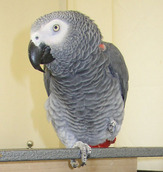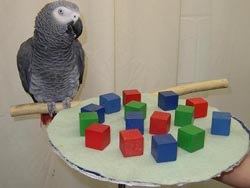
Few people actually use the term “birdbrain” to describe others, but practically anyone could define it. According to the Encarta Dictionary, “birdbrain” is “an offensive term for somebody who is regarded as silly or mildly unintelligent”. This would seem to imply that birds are silly or mildly unintelligent- a claim that many would back. Birds don’t always act intelligently. They fly into windows or in front of cars, and spent their time hopping around or sitting on telephone wires. Are birds even capable of intelligent thought?
Dr. Irene Pepperberg would argue that they are, and, had he not passed away in 2007, Alex would agree with her. He would count how many intelligent birds he knew and, if asked how many birds were actually birdbrains, would reply, “None.” This is nothing impressive- except that Alex was not a human. He was an African Grey Parrot- an Avian Language EXperiment.
There are several species of birds that are able to “talk”- to learn a word and match it to an object or situation. They may screech, “Key!” upon hearing the jingle of dropped keys, or say “Goodbye” as their owner walks out of the house. This is language, but it is not communication. Dr. Pepperberg wanted to know if her parrot, Alex, could truly communicate with her- to form his own thoughts and express them to her.
There are several species of birds that are able to “talk”- to learn a word and match it to an object or situation. They may screech, “Key!” upon hearing the jingle of dropped keys, or say “Goodbye” as their owner walks out of the house. This is language, but it is not communication. Dr. Pepperberg wanted to know if her parrot, Alex, could truly communicate with her- to form his own thoughts and express them to her.

A series of tests that could indicate true comprehension and communication involved numbers and counting. There were two main ways that Dr. Pepperberg assessed Alex’s progress. In one kind of test, Alex would be presented with a number of items. Often, they were scraps of cloth, pieces of cork, wood chips, or nuts. Dr. Pepperberg would ask Alex how many of the item he saw. For example, she might show him a tray with squares of yellow fabric, pieces of brown wood, and squares of brown fabric scattered across it. She would then ask a simple question, such as “How many brown cloth?” After learning the words for numbers and the names of the items, Alex was almost always able to correctly count the objects.
The science world was not always accepting of Dr. Pepperberg’s findings. They suspected that Alex’s ability to count- as well as his capability to add- wasn’t actually a deliberate thought. It was believed that Alex was similar to Clever Hans, a German horse that also appeared to be able to add. People were amazed that, if asked what four and two or three and five or anything other combination of numbers that added up to less than twelve equaled, Clever Hans would tap out the answer with his hoof. It was an extraordinary thought: a horse understood German and could complete simple math problems! However, when more research was done, Clever Hans turned out to be highly trained- not highly cognitive. When he had tapped out the correct number, his trainer-without even being aware of what he was doing- would slightly incline his head, and the horse would stop tapping. That Alex was able to give correct answers to anyone who asked him questions, even when Dr. Pepperberg wasn’t present, differentiated him from Clever Hans, but more startling evidence was yet to come.
It came out of the blue, while Dr. Pepperberg was conducting the second kind of number test- one that would show that Alex’s understanding of numbers was more advanced than a human toddler’s. As she explains in her book Alex and Me, “We now wanted to find out if Alex truly comprehended the number labels he used. When you ask a child below the age of three, ‘How many?’ when holding up four objects, she will likely answer correctly, ‘Four.’ Ask the same child to give you four marbles from a dish of them, and she will just scoop up a handful and give them to you. As with words, number production does not necessarily mean comprehension.” For this test, Alex would be shown a tray with groups of different objects. There might be, for example, two red blocks, three green blocks, and four blue blocks. As in the other kind of tests, Dr. Pepperberg would ask a simple question, such as, “What color three?” If Alex actually understood, he would answer, “Green.” Alex had little difficultly answering correctly.
The science world was not always accepting of Dr. Pepperberg’s findings. They suspected that Alex’s ability to count- as well as his capability to add- wasn’t actually a deliberate thought. It was believed that Alex was similar to Clever Hans, a German horse that also appeared to be able to add. People were amazed that, if asked what four and two or three and five or anything other combination of numbers that added up to less than twelve equaled, Clever Hans would tap out the answer with his hoof. It was an extraordinary thought: a horse understood German and could complete simple math problems! However, when more research was done, Clever Hans turned out to be highly trained- not highly cognitive. When he had tapped out the correct number, his trainer-without even being aware of what he was doing- would slightly incline his head, and the horse would stop tapping. That Alex was able to give correct answers to anyone who asked him questions, even when Dr. Pepperberg wasn’t present, differentiated him from Clever Hans, but more startling evidence was yet to come.
It came out of the blue, while Dr. Pepperberg was conducting the second kind of number test- one that would show that Alex’s understanding of numbers was more advanced than a human toddler’s. As she explains in her book Alex and Me, “We now wanted to find out if Alex truly comprehended the number labels he used. When you ask a child below the age of three, ‘How many?’ when holding up four objects, she will likely answer correctly, ‘Four.’ Ask the same child to give you four marbles from a dish of them, and she will just scoop up a handful and give them to you. As with words, number production does not necessarily mean comprehension.” For this test, Alex would be shown a tray with groups of different objects. There might be, for example, two red blocks, three green blocks, and four blue blocks. As in the other kind of tests, Dr. Pepperberg would ask a simple question, such as, “What color three?” If Alex actually understood, he would answer, “Green.” Alex had little difficultly answering correctly.
Like a highly gifted child in a regular class setting, Alex grew tired of repeating the simple tests over and over again. He began to give incorrect answers, repeat unrelated words, ask for treats, and say every possible answer except for the correct one. After some time, he tired of this as well. One day, Dr. Pepperberg showed him a tray with colored blocks in groups of two, three, and six. She asked him, “What color three?” His answer was “five”, but there was something about the way he said it that made Dr. Pepperberg stop. Instead of trying the test again or getting frustrated and giving up, she decided to humor him and asked, “What color five?” She expected another false answer, or a puzzled silence, because there was no group of five on the tray. The answer she got shocked her and marked a major milestone in her study.
Alex’s answer was, “None.”
Dr. Pepperberg could hardly believe what she was hearing. It appeared that Alex had, without ever being taught, grasped the concept of zero. He had never been given a test where “none” was an answer. Even for humans, zero is something that is difficult to understand, as it is highly abstract. Western culture did not even have a label for this concept before the seventeenth century. Even now, it is hard to define “zero” or “none” without using one of the two terms. It’s not always the answer people land upon. If someone eating a bowl of grapes was asked how many strawberries they had, they would be confused and find it difficult to answer. “How many strawberries do I have? You mean with me? These are grapes. I have two dozen grapes. Why are you asking me about strawberries?”
This was not the only time that Alex showed Dr. Pepperberg that birds were capable of more thought than science gave them credit for. Alex’s ability to understand numbers and the idea of zero is just one example of the many groundbreaking tests that give credit to Dr. Pepperberg’s theory that parrots are anything but birdbrains.
Alex’s answer was, “None.”
Dr. Pepperberg could hardly believe what she was hearing. It appeared that Alex had, without ever being taught, grasped the concept of zero. He had never been given a test where “none” was an answer. Even for humans, zero is something that is difficult to understand, as it is highly abstract. Western culture did not even have a label for this concept before the seventeenth century. Even now, it is hard to define “zero” or “none” without using one of the two terms. It’s not always the answer people land upon. If someone eating a bowl of grapes was asked how many strawberries they had, they would be confused and find it difficult to answer. “How many strawberries do I have? You mean with me? These are grapes. I have two dozen grapes. Why are you asking me about strawberries?”
This was not the only time that Alex showed Dr. Pepperberg that birds were capable of more thought than science gave them credit for. Alex’s ability to understand numbers and the idea of zero is just one example of the many groundbreaking tests that give credit to Dr. Pepperberg’s theory that parrots are anything but birdbrains.